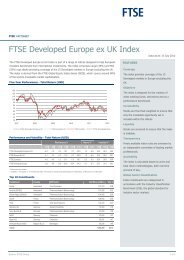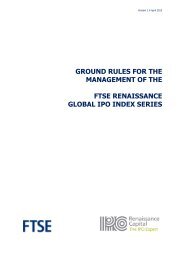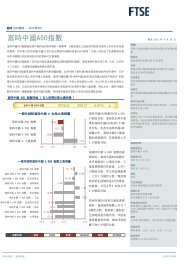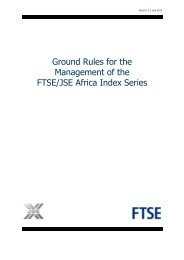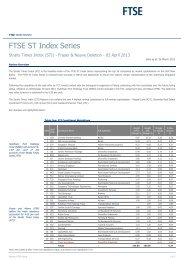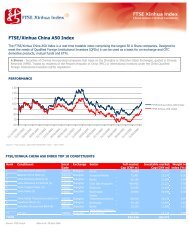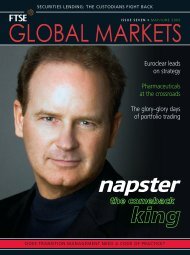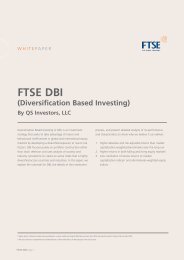Create successful ePaper yourself
Turn your PDF publications into a flip-book with our unique Google optimized e-Paper software.
TODAY’S SPIRITUOUS FRENZY is a return of an<br />
older cycle of trade. In the seventeenth and<br />
eighteenth centuries, the distillation of brandy and<br />
rum helped turn the engines of world commerce, leading<br />
to the development of the modern Atlantic economy. New<br />
Englanders traded their cod for molasses from the<br />
Caribbean, which they made into rum. Apart from<br />
drinking lots of it themselves, it was a major article of trade<br />
for the slavers.<br />
Alcohol was also a major source of early trade wars since<br />
the French and Spanish tried to protect their domestic<br />
brandy producers from colonial competition by banning<br />
the rum trade, and distillers worldwide used their<br />
domestic clout to ensure that foreign rivals were taxed at a<br />
much higher rate.<br />
People have always thought that tipple from across the<br />
sea was more exotic and chic than anything produced in<br />
their hometown distilleries. Colonial Americans, for<br />
example, oft times paid a premium for Jamaica Rum over<br />
their local New England variety, while their contemporary<br />
British paid more for sometimes-smuggled French brandy<br />
rather than locally produced gin or whisky.<br />
Eventually, that led to the development of global brands<br />
recognised across the drinking world. In more recent times,<br />
World Trade Organisation rulings and free trade<br />
agreements have now cut back on the previous tariff<br />
barriers that penalised foreign spirits, creating a real world<br />
market. Countries may tax drinking heavily, but they can<br />
no longer favour local distilleries.<br />
In the last ten years, as a result of these developments,<br />
the industry has steadily grown from a relatively high<br />
population of small family-owned enterprises to a much<br />
smaller group of massive international companies. And,<br />
just as in the buccaneering Rum era, French, British and<br />
American giants are now playing a modern form of poker<br />
across the Atlantic table.<br />
So far advanced is the process of consolidation that to<br />
stay one step ahead of the regulators, recent takeovers have<br />
involved shuffling brands between rivals so that each can<br />
maintain a balanced portfolio of products without<br />
developing a monopoly in any one sector. Because this is a<br />
global business, companies<br />
have to comply with Fizz and pop in the spirit world<br />
European and US anti- 500<br />
monopoly regulations, and 450<br />
400<br />
each merger and<br />
350<br />
acquisition results in a 300<br />
judicious reshuffle of 250<br />
brands as the companies 200<br />
150<br />
try to assemble the hands<br />
100<br />
they want to deal in each 50<br />
of the big markets.<br />
0<br />
Driving the present barroom<br />
brawl is the growing<br />
popularity, and even faster<br />
Allied Domecq Pernod–Ricard<br />
growing profitability, of<br />
Diageo Fortune Brands<br />
premium branded spirits.<br />
Apr-00<br />
Oct-00<br />
<strong>FTSE</strong> GLOBAL MARKETS • JULY/AUGUST 2005<br />
Apr-01<br />
Oct-01<br />
Apr-02<br />
Oct-02<br />
Constellation Brands A<br />
<strong>FTSE</strong> Beverages <strong>Index</strong><br />
Data as at June 05. Source: <strong>FTSE</strong> Group/FactSet Limited (Price <strong>Index</strong> values in US Dollars)<br />
Once a heavily taxed luxury, rising affluence and declining<br />
relative prices have caused spirit consumption to soar –<br />
especially in the branded varieties where the wiles of<br />
marketers can persuade drinkers that there is enough<br />
virtue in a branded variety of pure ethanol and water to be<br />
worth five times the price of a generic equivalent. Young<br />
people in their twenties in particular are downing spirits.<br />
Sales in the US for example are rising by 4.1% a year, while<br />
beer drinking, at 0.5% annual growth, these days can<br />
hardly raise its froth above the glass.<br />
Marketers have successfully persuaded significant<br />
numbers of the bright twenties age group that only much<br />
more expensive super-premium brands have the necessary<br />
cachet. Furthermore, these days it is peer-group social<br />
death to be seen drinking lesser brands without the lore. As<br />
a result Impact Databank, the alcohol sellers’ bible,<br />
assessed the value of the world's top 100 spirits brands as<br />
rising 5% to $56bn last year.<br />
That price and worth are not necessarily identical is<br />
suggested by American Sidney Frank’s sale of the “Grey<br />
Goose”vodka brand to Bacardi for $2bn last September. It is<br />
perhaps symptomatic that Frank began his career making<br />
alcohol-based jet fuel. His “invention” of Grey Goose was<br />
based on sound economic principles. As he has explained,“A<br />
bottle of Absolut sells for $20 a bottle.Vodka is just water and<br />
alcohol, so if I sold a bottle for $30, the $10 difference is<br />
almost all profit.”He knew that there is nothing as easy as<br />
parting a snob from his money, and made Grey Goose in<br />
France, to tickle American consumers’sense of chic.<br />
There is indeed room for a little boy to do the emperor’s<br />
new clothes routine on drinks such as premium vodka.<br />
Dimitry Mendeleyev took time off from laying the Periodic<br />
table of Elements to draw up the specifications for vodka<br />
for the Tsar in 1894. It comprised 60% water and 40%<br />
ethanol. So the major difference in premium drinks is the<br />
label on the bottle – and the price. Since most of the<br />
drinkers add mixers or drink the vodka as part of a cocktail,<br />
any homeopathic differences between brands would need<br />
a gas chromatograph to identify. One envisages a world full<br />
of unscrupulous bar-owners decanting basic vodka into<br />
expensive bottles every evening.<br />
Apr-03<br />
Oct-03<br />
Apr-04<br />
Oct-04<br />
Apr-05<br />
But with the mysterious<br />
alchemy of branding, Grey<br />
Goose has left former<br />
premium brands behind,<br />
as mere cooking vodkas<br />
for the undiscerning. It has<br />
also triggered a chain<br />
reaction as other firms<br />
have sought to put alcohol<br />
and water in pretty bottles<br />
that attracted superpremium<br />
prices.<br />
Its very simplicity is<br />
what makes vodka perfect<br />
for this form of comodification.<br />
However,<br />
65



